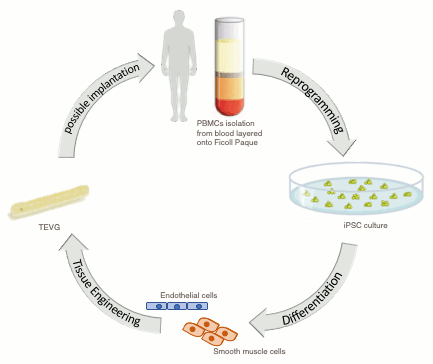Autologous endothelialized small-caliber vascular grafts engineered from blood-derived induced pluripotent stem cells

An ideal cell source for human therapeutic and disease modeling applications should be easily accessible and possess unlimited differentiation and expansion potential. Human induced pluripotent stem cells (hiPSCs) derived from peripheral blood mononuclear cells (PBMCs) represent a promising source given their ease of harvest and their pluripotent nature. Previous studies have demonstrated the feasibility of using PBMC-derived hiPSCs for vascular tissue engineering. However, so far, no endothelialization of hiPSC-derived tissue engineered vascular grafts (TEVGs) based on fully biodegradable polymers without xenogenic matrix components has been shown.
We report for the first time the possibility to employ human peripheral blood mononuclear cell (PBMC)-derived iPSCs to generate biodegradable polymer-based tissue engineered vascular grafts (TEVG), which mimic the native layered architecture of blood vessels. Human iPSCs were generated from PBMCs and differentiated into αSMA- and calponin-positive smooth muscle cells (SMCs) as well as endothelial cells (ECs) positive for CD31, vWF and eNOS. Both cell types were co-seeded on PGA-P4HB starter matrices and cultured under static or dynamic conditions to induce tissue formation in vitro. The resulting small diameter vascular grafts showed abundant amounts of extracellular matrix, containing a thin luminal layer of vWF-positive cells and a subendothelial αSMA-positive layer approximating the architecture of native vessels. Our results demonstrate the successful generation of TEVGs based on SMCs and ECs differentiated from PBMC-derived hiPSC combined with a biodegradable polymer. These results pave the way for developing autologous PBMC-derived hiPSC-based vascular constructs for therapeutic applications or disease modeling. Furthermore, our findings improving the generation of autologous vascular replacements using blood as an easily accessible cell source.
The full article, published at https://doi.org/10.1016/j.actbio.2019.07.032, was written by Melanie Generali as part of her PhD project with the contribution of Elisa A. Casanova, Debora Kehl, Debora Wanner, Simon P. Hoerstrup, Paolo Cinelli* and Benedikt Weber* (*These senior authors contributed equally to this study).